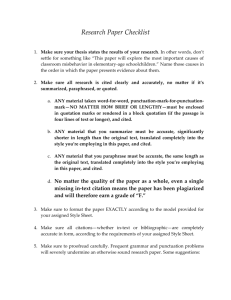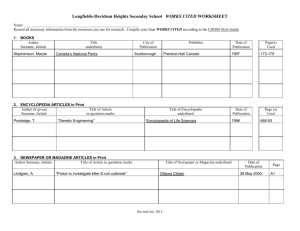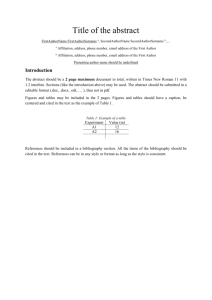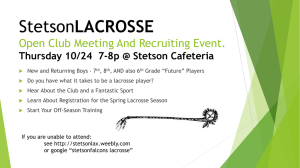Penguin, 1985. Print.
advertisement
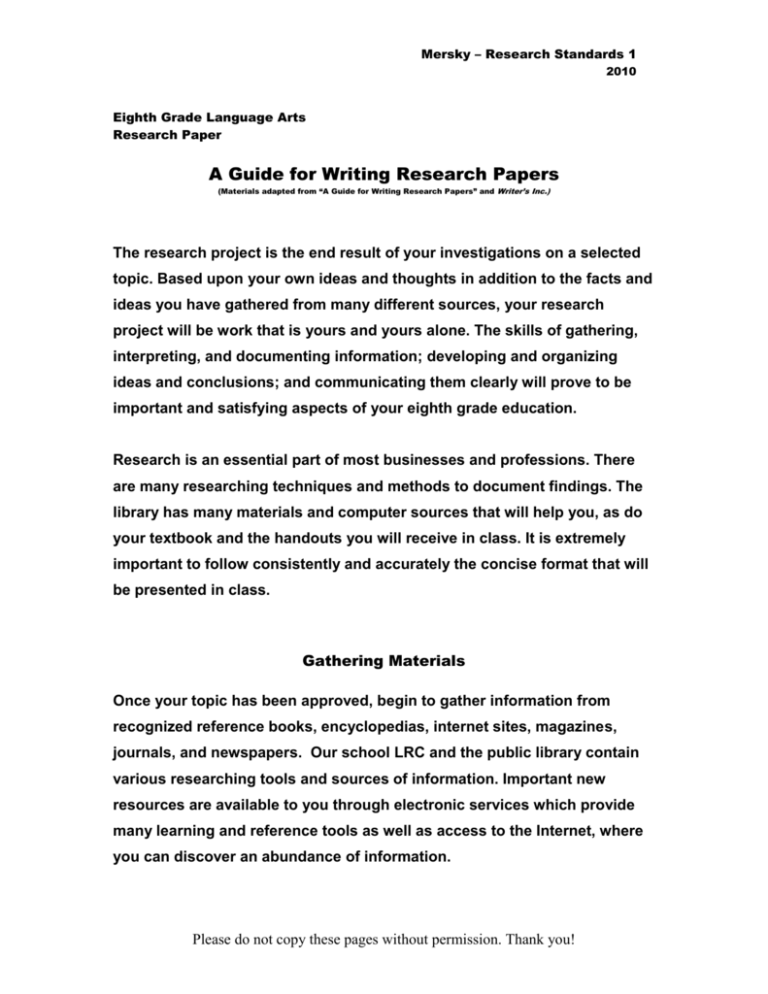
Mersky – Research Standards 1 2010 Eighth Grade Language Arts Research Paper A Guide for Writing Research Papers (Materials adapted from “A Guide for Writing Research Papers” and Writer’s Inc.) The research project is the end result of your investigations on a selected topic. Based upon your own ideas and thoughts in addition to the facts and ideas you have gathered from many different sources, your research project will be work that is yours and yours alone. The skills of gathering, interpreting, and documenting information; developing and organizing ideas and conclusions; and communicating them clearly will prove to be important and satisfying aspects of your eighth grade education. Research is an essential part of most businesses and professions. There are many researching techniques and methods to document findings. The library has many materials and computer sources that will help you, as do your textbook and the handouts you will receive in class. It is extremely important to follow consistently and accurately the concise format that will be presented in class. Gathering Materials Once your topic has been approved, begin to gather information from recognized reference books, encyclopedias, internet sites, magazines, journals, and newspapers. Our school LRC and the public library contain various researching tools and sources of information. Important new resources are available to you through electronic services which provide many learning and reference tools as well as access to the Internet, where you can discover an abundance of information. Please do not copy these pages without permission. Thank you! Mersky – Research Standards 2 2010 Preparing a “Works Cited” Section Once you have found the sources you intend to use, you will need to identify them for your reader. For every source you use, create a separate listing (on a 3x5 or 4x6 card), giving the following information: For each BOOK you use, write a separate listing (on 3x5 or 4x6 card) giving author (last name first), book title (underlined), city of publication, publisher, date of publication, and “Print.” 1 Taylor, Margaret Roll of Thunder, Hear My Cry Evanston: McDougal Littell, 1997. Print For each ARTICLE you use from a magazine, journal, or newspaper, write a separate listing (on a 3x5 or 4x 6 card) giving author (last name first), article title (in quotation marks), source tile (underlined), date of publication, pages, and “Print.” 2 Prin, Dinah, and Allen Gillespie “Life in the Eighth Grade” New Yorker Magazine July 4, 1776 pp.23, 26-30 Print Please do not copy these pages without permission. Thank you! Mersky – Research Standards 3 2010 For each ARTICLE you use from a PRINT encyclopedia, write a separate listing (on a 3x5 or 4x 6 card) giving author (last name first), article title (in quotation marks), source tile (underlined) and “Print,” and date of publication. 2 Wardowski, Wilfred F. “Kumquat” World Book Encyclopedia Print 2004 p.477 For each WEB SITE you use from an Internet source, write a separate listing (on a 3x5 or 4x 6 card) giving author (last name first), name of page (underlined), date of posting , name of institution affiliated with the site, date of access, and “Web.” 3 Using Modern Language Association (MLA) Format Dec 2003 Purdue University 17 Mar. 2004 Web Please do not copy these pages without permission. Thank you! Mersky – Research Standards 4 2010 For each ARTICLE you use from an Internet source, write a separate listing (on a 3x5 or 4x 6 card) giving author (last name first), article title (in quotation marks), name of web site (underlined), date of posting ,name of institution affiliated with the site, “Web,” and date of access. 4 Poland, David. “The Cold Button” Roughcut 26 Oct. 1998. Turner Network Television Web 17 Mar. 2010 For each VIDEO SITE (You Tube) you use from an Internet source, write a separate listing (on a 3x5 or 4x 6 card) giving site title (in quotation marks), date of image, title of larger site, “Web,” and date of download. 5 “Woodstock 1969” No date You Tube Web 14 June 2009 You might also use other reference books, newspapers, electronic sources, audio-visual materials, and other sources of information. Documentation for these sources is listed in the works cited guide (pp.). Please do not copy these pages without permission. Thank you! Mersky – Research Standards 5 2010 Taking Notes As you examine each source, make a separate note of each fact or quotation you might want to use in your project. For each note card you create, you MUST include the following information on each and every note card: works cited reference number in the upper right-hand corner specific topic which corresponds to an item on your outline facts/quotations which match the topic and source page number in bottom right-hand corner of the note card 1 Unity in a Paragraph “When a paragraph has unity, all the sentences relate to the main idea.” A paragraph may have all the necessary elements but still needs unity for clear understanding. p.301 (Try to summarize the information in your own words; use quotation marks if you copy the information exactly.) Each specific topic should relate to your paper’s content. By arranging and rearranging the listings and using topic headings, you may discover areas where you need additional information, areas where you have a great deal of information, and/or areas that are not appropriate for your project. Please do not copy these pages without permission. Thank you! Mersky – Research Standards 6 2010 PLAGIARISM Using someone else’s ideas or phrasing and representing those ideas or phrasing as your own either on purpose or through carelessness, is a serious offense known as plagiarism. Please be certain that you understand the concept of plagiarism. The penalty for plagiarism is zero points for the content portion of your project. “Ideas or phrasing” includes written or spoken material, of course, but it also includes statistics, lab results, and art work. “Someone else” can mean a professional source (in a published work), an electronic source, or another person. If you do not understand the concept of plagiarism or the proper methods of documentation, please request assistance from your teacher or the librarians. Preparing the “Works Cited” Page from Your Listing of Resources Every work from which you derived information used in your project must have a works cited card and must be listed on the Works Cited page of the written portion of your project in the approved format. (See pages 10 - 15.) Each works cited card should be placed in alphabetical order by the author’s (editor’s) last name. If no author (editor) is given, alphabetize by the first word in the title of the piece. (In establishing alphabetical order, ignore the words “a,” “an,” and “the.”) A sample works cited page has been included on page 9. Please do not copy these pages without permission. Thank you! Mersky – Research Standards 7 2010 Final Oral Report Format and Requirements In addition to submitting a hardcopy of your work to Ms. Mersky on May 17, 2010, you MUST submit your work to turnitin.com. Paper: Use white, 81/2 x 11 inch paper. Margins: Leave one-inch margins around the written portion of your paper. (The normal default on most programs is adequate.) Spacing: The paper should be double-spaced. Title page: The title of your paper should appear approximately 1/3 down from the top of the page; it should be centered, appropriately capitalized without underlining or quotation marks. Your name, your teacher’s name, the course name and hour, and the date should appear – all on separate double-spaced lines – approximately 2/3 down the page and centered. (sample title page) Completing a Research Paper (centered) Your Name Ms. Mersky Language Arts 8 17 May 2010 Please do not copy these pages without permission. Thank you! Mersky – Research Standards 8 2010 Outline page: This is the second page of your written work. Center the title of your paper, approximately one inch down from the top of the page. Every entry on your outline page must be double-spaced. Below your title, place your thesis statement. Every entry (Roman numerals, capital letters, and numbers) must “line up.” The first Roman numeral entry (I.) is the word “Introduction.” The last Roman numeral entry (V. or higher) is the word “Conclusion.” (Sample outline page: this sample is abbreviated; yours must have greater detail.) Completing a Research Project This project will explore several aspects of successfully completing a research project: the background information, the process itself, and the presentation. I. Introduction II. Background into completing research A. Readings B. Classroom work III. The research process IV. Writing the paper V. Conclusion Written copy of presentation: A written copy of your presentation is the third part of the written work. Include your last name and the page number in the right corner of a header. The only heading is the title of your work, centered at the top of the first page. Make certain to include applicable internal documentation Please do not copy these pages without permission. Thank you! Mersky – Research Standards 9 2010 Works Cited page: This is the fourth and final portion of the required written work to be submitted with your note cards. The title of this page is Works Cited. The title is centered, but it is NOT underlined, in bold print, italicized, or placed in “quotation marks.” Double space before the first entry. The first line of each entry should be flush with the left margin. If the entry takes more than one line, the second line (and any additional lines needed for the entry) should be indented. This is known as a hanging indent or reverse indenting. Double space each entry; double space between entries. Entries should be listed alphabetically by author’s last name. If there is no author, order entries alphabetically by the first word of the title (omitting a, an, and the) Mersky 12 Works Cited “About Lacrosse.” US Lacrosse. Web. 3 Mar. 2009. Bright, Chris. “Lacrosse and the Iroquois.” World Watch Nov./Dec. 2001: 17-18. Worldwatch Institute. Web. 3 Nov. 2004. Fisher, Donald M. Lacrosse: A History of the Game. Baltimore: John Hopkins University Press, 2002. Print. Hoyt-Goldsmith, Diane. Lacrosse: The National Game of the Iroquois.” New York: Holiday House, 1998. Print. “Lacrosse.” The Columbia Encyclopedia. 6th ed. Print. Olson, Elizabeth. “Lacrosse Makes a Comeback.” New York Times 17 Feb. 2004: D5+. Print. US Lacrosse. “Participation Survey 2007.” Web. 9 Mar. 2009. Please do not copy these pages without permission. Thank you! Mersky – Research Standards 10 2010 Works Cited Examples Book with one author (or editor): Torre, Joe. The Yankee Years. New York: Doubleday, 2009. Print. Two or more books by the same author: After the first mention of the author’s name, use three hyphens followed by a period to indicate “same author as above.” Austen Jane. Northanger Abbey. Ed. Anne Henry Ehrenpreis. London, Penguin, 1985. Print. ---. Persuasion. Ed. D. W. Harding. London: Penguin, 1985. Print. Book with two or three authors (or editors): Cosby, Camille O., and Renee Poussaint. A Wealth of Wisdom: Legendary African American Elders Speak. New York, Atria, 2004. Print. Book with more than three authors (or editors): Odell, Lee, et al. Elements of Language – Second Course. Austin: Holt, Rinehart, and Winston, 2001. Print. Book with a corporate author: American Allergy Association. Allergies and Children. New York: Random House, 1998. Print. Book with no author named: Encyclopedia of Photography. New York: Crown Publishers, 1994. Print. Please do not copy these pages without permission. Thank you! Mersky – Research Standards 11 2010 One volume in a multi-volume work: McMahon, Thomas, ed. “Pablo Picasso.” Authors and the Artists for Young Adults. Vol. 20. Detroit: Gale Research, 1997. Print Government Publication: United States. U.S. General Accounting Office. Student Testing; Current Extent and Expenditures, with Cost Estimates for a National Examination. Washington, DC: GAO, 1993. Print. Pamphlet: Stevenson, George B. Trees of Everglades National Park and the Florida Keys, 2nd ed. Miami: Banyan, 1969. Print. Encyclopedia Article (author known): Barr, William: “Northwest Passage.” World Book Encyclopedia. 1998 ed. Print. Encyclopedia Article (author unknown): “The Great Depression.” Encyclopedia Americana. 1978 ed. Print. Magazine article (author known): Prin, Dinah, and Allen Gillespie. “Life in the Eighth Grade.” New Yorker Magazine. 4 July, 1776: 23, 26-30. Print. Please do not copy these pages without permission. Thank you! Mersky – Research Standards 12 2010 Magazine article (author unknown): “The Decade of the Spy.” Newsweek. 7 March 1994: 26-27. Print Newspaper article (author known): Taub, Erica A. “Webcam Brings 3-D to Topps Sports Cards.” New York Times 9 Mar. 2009, Southern ed. B4. Print. Newspaper Editorial “Voting Rights Progress.” Editorial. Wall Street Journal 10 Mar. 2009: A14. Print. Newspaper Column: Geithner, Timothy, and Shaun Donovan. Housing Plan’s Aim: Help People Help Themselves.” USA Today 19 Feb 2009: 9A. Print. Letter to the Editor: Johnson, Shirley. Letter. Palm Beach Post 6 Mar. 2009: A12. Print Internet Sources: On-line images: Smith, Greg. “Rhesus Monkey in the Zoo.” 1989. Monkey Picture Gallery. Web. 3 May 2003. Please do not copy these pages without permission. Thank you! Mersky – Research Standards 13 2010 Online Magazine Article: Landsburg, Steven E. “Grade Expectations.” Slate 12Aug. 1999. Web. 12 Jan. 2008. Online Newspaper Article: Associated Press. “Freeing Willy, in Real Life.” New York Times on the Web 8 Sept. 1999. Web. 22 Dec. 1999. Online Reference Work: Tufts, Eleanor. “Cassatt, Mary.” Grolier Multimedia Encyclopedia. Scholastic. 2004. Web. 19 Sept. 2004. Online Video: Murphy, Professor Kevin. “Robert Frost’s ‘The Road Not Take,.’ ” You Tube. Ithaca College, New York. Web. 6 Mar. 2009. Professional Web Site: Victorian Women Writers Project. Ed. Perry Willett. Dec. 2000. Indiana U. Web. 3 Feb. 2003. Page on Web Site “Information Technology.” Career Voyages. U.S. Departments of Labor and Education. 9 Feb 2008. Web. 12 May 2010. Please do not copy these pages without permission. Thank you! Mersky – Research Standards 14 2010 “NFL Standings: Division.” National Football League (NFL). 6 Mar. 2009. Web. 7 Mar. 2009. Stolley, Karl, Kristen Seas, Tony Rouse, and Elizabeth Angeli. “MLA Formatting and Style Guide.” The OWL (Online Writing Lab) at Purdue. 25 Feb. 2009. Web. 16 Oct. 2009. “Where We Work: Around the World and in a Myriad of Habitats.” The Nature Conservancy. 2009 Web. 14 Oct. 2009. Other Sources: Television or Radio Program: Nightly News with Brian Williams. NBC. WPTV-TV5. Boynton Beach, FL. 12 Feb. 2010. Television. Film or Video Recording: Bram Stoker’s Dracula. Dir. Francis Ford Coppola. Sony Pictures Home Entertainment. 2007. Film. Interview that you conducted: Redford, Robert. Personal interview. 24 Sept. 1996. Interview that you observed: Clinton, Bill. Interview with Ted Koppel. Nightline. ABC. WTNH, New Haven. 14 Nov. 1996. Television. Please do not copy these pages without permission. Thank you! Mersky – Research Standards 15 2010 Print advertisement: Lufthansa. Advertisement. Time. 29 Nov. 2000: 151. Print TV advertisement: Staples. Advertisement. CBS. 3 Dec. 2000. Television. Sound recording: U2. All That You Can Leave Behind. Interscope, 2000. Documentation information based upon: Goldenberg, Phyllis. Writing a Research Paper. New York: William H. Sadlier, Inc. 2010. Print. Please do not copy these pages without permission. Thank you!
